Effect of Heat Treatment on the Microstructure and Mechanical Properties of the Al0.6CoCrFeNi High-Entropy Alloy
Abstract
:1. Introduction
2. Materials and Methods
3. Results
3.1. Microstructures of as-Cast Al0.6CoCrFeNi Alloy
3.2. Microstructure of Annealed Al0.6CoCrFeNi Alloy
3.3. In Situ XRD Analysis of Al0.6CoCrFeNi Alloy
3.4. Mechanical Properties of as-Cast and Annealed Al0.6CoCrFeNi Alloy
4. Discussion
5. Conclusions
Author Contributions
Funding
Institutional Review Board Statement
Informed Consent Statement
Data Availability Statement
Conflicts of Interest
References
- Cantor, B.; Chang, I.T.H.; Knight, P.; Vincent, A.J.B. Microstructural development in equiatomic multicomponent alloys. Mater. Sci. Eng. A 2004, 375–377, 213–218. [Google Scholar] [CrossRef]
- Yeh, J.W.; Chen, S.K.; Lin, S.J.; Gan, J.Y.; Chin, T.S.; Shun, T.T.; Tsau, C.H.; Chang, S.Y. Nanostructured high-entropy alloys with multiple principal elements: Novel alloy design concepts and outcomes. Adv. Eng. Mater. 2004, 6, 299–303. [Google Scholar] [CrossRef]
- Takeuchi, A.; Amiya, K.; Wada, T.; Yubuta, K.; Zhang, W. High-entropy alloys with a hexagonal close-packed structure designed by equi-atomic alloy strategy and binary phase diagrams. JOM 2014, 66, 1984–1992. [Google Scholar] [CrossRef]
- Cao, L.; Wang, X.; Wang, Y.; Zhang, L.; Yang, Y.; Liu, F.; Cui, Y. Microstructural evolution, phase formation and mechanical properties of multi-component AlCoCrFeNix alloys. Appl. Phys. A 2019, 125, 699. [Google Scholar] [CrossRef]
- Gwalani, B.; Soni, V.; Lee, M.; Mantri, S.; Ren, Y.; Banerjee, R. Opimizing the coupled effects of Hall-Petch and precipitation strengthening in a Al0.3CoCrFeNi high entropy alloy. Mater. Des. 2017, 121, 254–260. [Google Scholar] [CrossRef]
- Huang, H.; Wu, Y.; He, J.; Wang, H.; Liu, X.; An, K.; Wu, W.; Lu, Z. Phase-transformation ductilization of brittle high-entropy alloys via metastability engineering. Adv. Mater. 2017, 29, 1701678. [Google Scholar] [CrossRef]
- He, J.; Wang, H.; Huang, H.; Xu, X.; Chen, M.; Wu, Y.; Liu, X.; Nieh, T.G.; An, K.; Lu, Z. A precipitation-hardened high-entropy alloy with outstanding tensile properties. Acta Mater. 2016, 102, 187–196. [Google Scholar] [CrossRef]
- Bian, Y.L.; Feng, Z.D.; Zhang, N.B.; Li, Y.X.; Wang, X.F.; Zhang, B.B.; Cai, Y.; Lu, L.; Chen, S.; Yao, X.H.; et al. Ultrafast severe plastic deformation in high-entropy alloy Al0.1CoCrFeNi via dynamic equal channel angular pressing. Mater. Sci. Eng. A 2022, 847, 143221. [Google Scholar] [CrossRef]
- Schuh, B.; Mendez-Martin, F.; Völker, B.; George, E.P.; Clemens, H.; Pippan, R.; Hohenwarter, A. Mechanical properties, microstructure and thermal stability of a nanocrystalline CoCrFeMnNi high-entropy alloy after severe plastic deformation. Acta Mater. 2015, 96, 258–268. [Google Scholar] [CrossRef]
- Li, J.; Yang, H.; Wang, W.Y.; Kou, H.; Wang, J. Thermal-mechanical processing and strengthen in AlxCoCrFeNi High-Entropy Alloys. Front. Mater. 2021, 7, 585602. [Google Scholar] [CrossRef]
- Kao, Y.F.; Chen, T.J.; Chen, S.K.; Yeh, J.W. Microstructure and mechanical property of as-cast, -homogenized, and -deformed AlxCoCrFeNi (0≤ x ≤2) high-entropy alloys. J. Alloys Compd. 2009, 488, 57–64. [Google Scholar] [CrossRef]
- Niu, S.; Kou, H.; Zhang, Y.; Wang, J.; Li, J. The characteristics of serration in Al0.5CoCrFeNi high entropy alloy. Mater. Sci. Eng. A 2017, 702, 96–103. [Google Scholar] [CrossRef]
- Gangireddy, S.; Gwalani, B.; Soni, V.; Banerjee, R.; Mishra, R. Contrasting mechanical behavior in precipitation hardenable AlxCoCrFeNi high entropy alloy microstructures: Single phase FCC vs dual phase FCC-BCC. Mater. Sci. Eng. A 2019, 739, 158–166. [Google Scholar] [CrossRef]
- Wang, W.R.; Wang, W.L.; Wang, S.C.; Tsai, Y.C.; Lai, C.H.; Yeh, J.W. Effects of Al addition on the microstructure and mechanical property of AlxCoCrFeNi high-entropy alloys. Intermetallics 2012, 26, 44–51. [Google Scholar] [CrossRef]
- Munitz, A.; Salhov, S.; Hayun, S.; Frage, N. Heat treatment impacts the micro-structure and mechanical properties of AlCoCrFeNi high entropy alloy. J. Alloys Compd. 2016, 683, 221–230. [Google Scholar] [CrossRef]
- Manzoni, A.; Daoud, H.; Völkl, R.; Glatzel, U.; Wanderka, N. Phase separation in equiatomic AlCoCrFeNi high-entropy alloy. Ultramicroscopy 2013, 132, 212–215. [Google Scholar] [CrossRef] [PubMed]
- Chen, M.; Lan, L.; Shi, X.; Yang, H.; Zhang, M.; Qiao, J. The tribological properties of Al0.6CoCrFeNi high-entropy alloy with the σ phase precipitation at elevated temperature. J. Alloys Compd. 2019, 777, 180–189. [Google Scholar] [CrossRef]
- Niu, S.; Kou, H.; Wang, J.; Li, J. Improved tensile properties of Al0.5CoCrFeNi high-entropy alloy by tailoring microstructures. Rare Metals 2021, 40, 2508–2513. [Google Scholar] [CrossRef]
- Wang, J.; Yang, H.; Guo, T.; Wang, J.; Wang, W.; Li, J. Effect of cold rolling on the phase transformation kinetics of an Al0.5CoCrFeNi high-entropy alloy. Entropy 2019, 20, 917. [Google Scholar] [CrossRef]
- Shi, P.; Li, R.; Li, Y.; Wen, Y.; Zhong, Y.; Ren, W.; Shen, Z.; Zheng, T.; Peng, J.; Liang, X.; et al. Hierarchical crack buffering triples ductility in eutectic herringbone high-entropy alloys. Science 2021, 373, 912–918. [Google Scholar] [CrossRef]
- Dong, Y.; Jiang, L.; Tang, Z.; Lu, Y.; Li, T. Effect of electromagnetic field on microstructure and properties of bulk AlCrFeNiMo0.2 high-entropy alloy. J. Mater. Eng. Perf. 2015, 24, 4475–4481. [Google Scholar] [CrossRef]
- Ng, C.; Guo, S.; Luan, J.H.; Wang, Q.; Lu, J.; Shi, S.Q.; Liu, C.T. Phase stability and tensile properties of Co-free Al0.5CrCuFeNi2 high-entropy alloys. J. Alloys Compd. 2014, 584, 530–537. [Google Scholar] [CrossRef]
- Sun, S.J.; Tian, Y.Z.; Lin, H.R.; Dong, X.G.; Wang, Y.H.; Zhang, Z.J.; Zhang, Z.F. Enhanced strength and ductility of bulk CoCrFeMnNi high entropy alloy having fully recrystallized ultrafine-grained structure. Mater. Des. 2017, 133, 122–127. [Google Scholar] [CrossRef]
- Park, J.M.; Moon, J.; Bae, J.W.; Jung, J.; Lee, S.; Kim, H.S. Effect of annealing heat treatment on microstructural evolution and tensile behavior of Al0.5CoCrFeMnNi high-entropy alloy. Mater. Sci. Eng. A 2018, 728, 251–258. [Google Scholar] [CrossRef]
- GB/T 228.1-2010; Metallic Materials—Tensile Testing—Part 1: Method of Test at Room Temperature. National Standard of the People’s Republic of China: Beijing, China, 2010.
- Wang, W.R.; Wang, W.L.; Yeh, J.W. Phases, microstructure and mechanical properties of AlxCoCrFeNi high-entropy alloys at elevated temperatures. J. Alloys Compd. 2014, 589, 143–152. [Google Scholar] [CrossRef]
- Gwalani, B.; Gorsse, S.; Choudhuri, D.; Styles, M.; Zheng, Y.F.; Mishra, R.S.; Banerjee, R. Modifying transformation pathways in high entropy alloys or complex concentrated alloys via thermo-mechanical processing. Acta. Mater. 2018, 153, 169–185. [Google Scholar] [CrossRef]
- Dong, Y.; Jiang, L.; Jiang, H.; Lu, Y.; Wang, T.; Li, T. Effects of annealing treatment on microstructure and hardness of bulk AlCrFeNiMo0.2 eutectic high-entropy alloy. Mater. Des. 2015, 82, 91–97. [Google Scholar] [CrossRef]
- Guo, T.; Li, J.; Wang, J.; Wang, W.Y.; Liu, Y.; Luo, X.; Kou, H.; Beaugnon, E. Microstructure and properties of bulk Al0.5CoCrFeNi high-entropy alloy by cold rolling and subsequent annealing. Mater. Sci. Eng. A 2018, 729, 141–148. [Google Scholar] [CrossRef]
- Zhang, C.; Zhang, F.; Chen, S.L.; Cao, W.S. Computational thermodynamics aided high-entropy alloy design. JOM 2012, 64, 839–845. [Google Scholar] [CrossRef]
- Tsai, K.Y.; Tsai, M.H.; Yeh, J.W. Sluggish diffusion in Co-Cr-Fe-Mn-Ni high-entropy alloys. Acta Mater. 2013, 61, 4887–4897. [Google Scholar] [CrossRef]
- Qu, S.; Li, Y.; Wang, C.; Liu, X.; Qian, K.; Ruan, J.; Chen, Y.; Yang, Y. Coarsening behavior of γ′ precipitates and compression deformation mechanism of a novel Co-V-Ta-Ti superalloy. Mater. Sci. Eng. A 2020, 787, 139455. [Google Scholar] [CrossRef]
- Tsai, M.H.; Yuan, H.; Cheng, G.M.; Xu, W.Z.; Jian, W.W.; Chuang, M.H.; Juan, C.C.; Yeh, A.C.; Lin, S.J.; Zhu, Y.T. Significant hardening due to the formation of a sigma phase matrix in a high entropy alloy. Intermetallics 2013, 33, 81–86. [Google Scholar] [CrossRef]
- Nassar, A.; Mullis, A.; Cochrane, R.; Aslam, Z.; Micklethwaite, S.; Cao, L. Rapid solidification of AlCoCrFeNi2.1 high-entropy alloy. J. Alloys Compd. 2022, 900, 163350. [Google Scholar] [CrossRef]
- Ren, J.; Zhang, Y.; Zhao, D.; Chen, Y.; Guan, S.; Liu, Y.; Liu, L.; Peng, S.; Kong, F.; Poplawsky, J.D.; et al. Strong yet ductile nanolamellar high-entropy alloys by additive manufacturing. Nature 2022, 608, 62–68. [Google Scholar] [CrossRef] [PubMed]
- Lu, Y.; Wu, X.; Fu, Z.; Yang, Q.; Zhang, Y.; Liu, Q.; Li, T.; Tian, Y.; Tan, H.; Li, Z.; et al. Ductile and ultrahigh-strength eutectic high-entropy alloys by large-volume 3D printing. J. Mater. Sci. Technol. 2022, 126, 15–21. [Google Scholar] [CrossRef]
- Li, J.; Jia, W.; Wang, J.; Kou, H.; Zhang, D.; Beaugnon, E. Enhanced mechanical properties of a CoCrFeNi high entropy alloy by supercooling method. Mater. Des. 2016, 95, 183–187. [Google Scholar] [CrossRef]
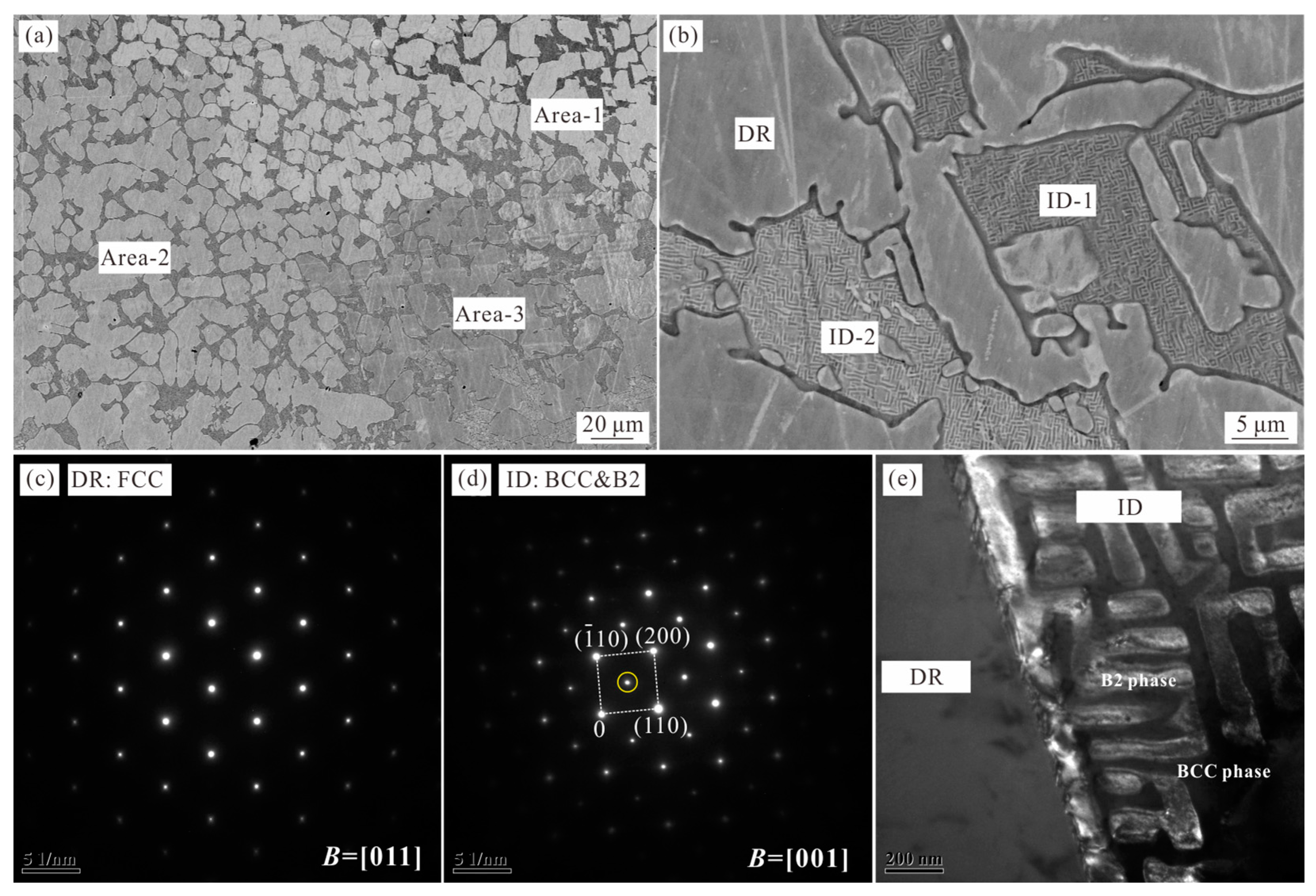
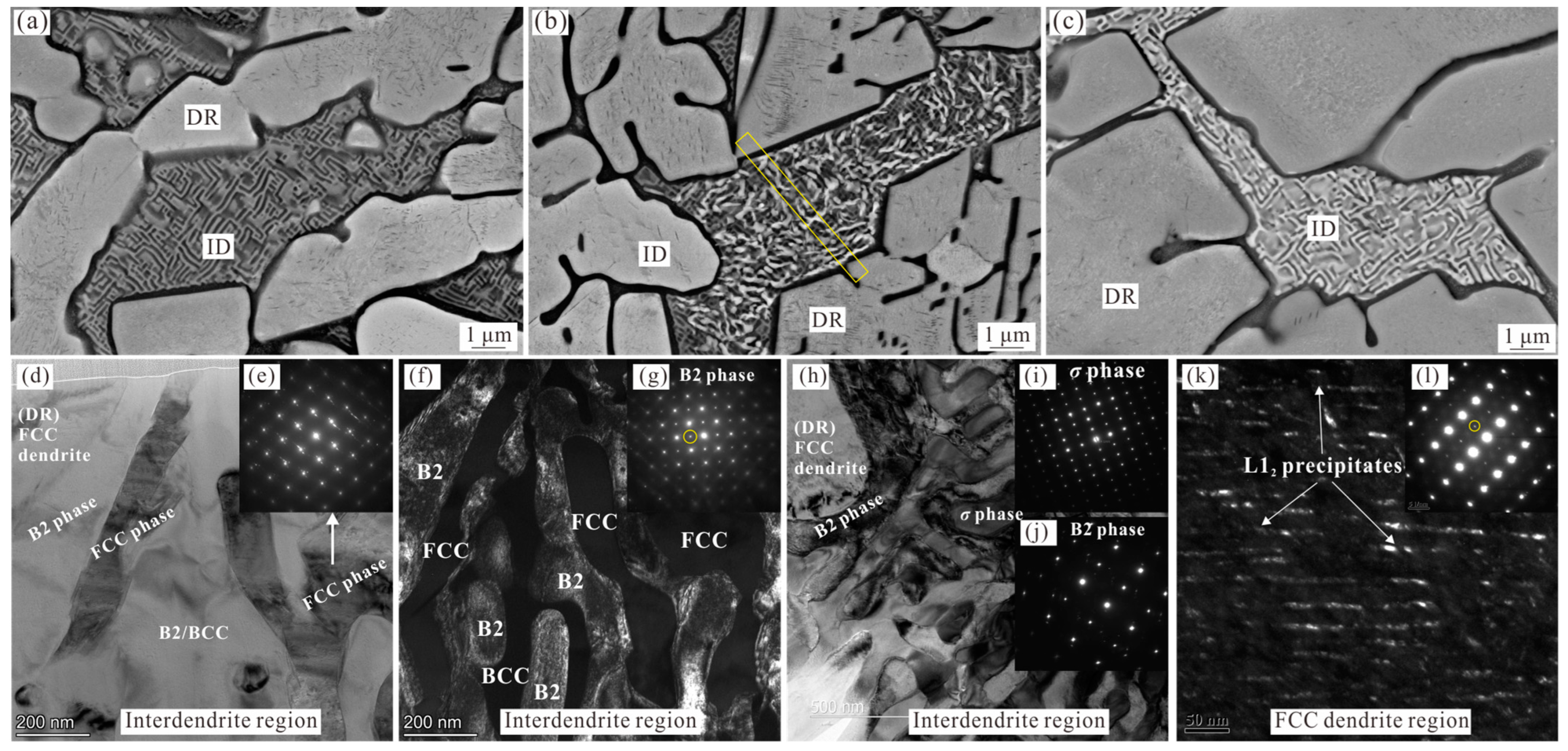

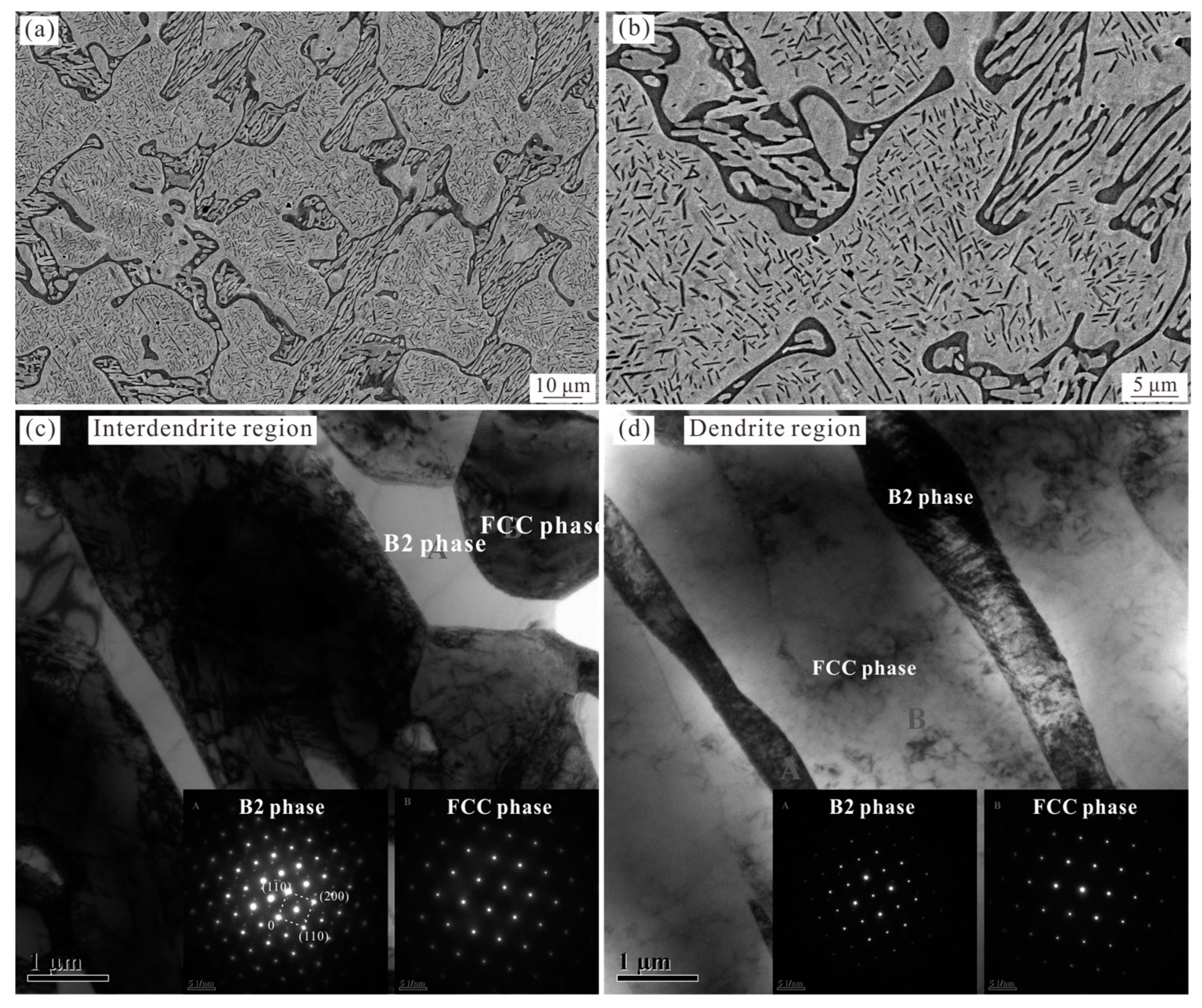

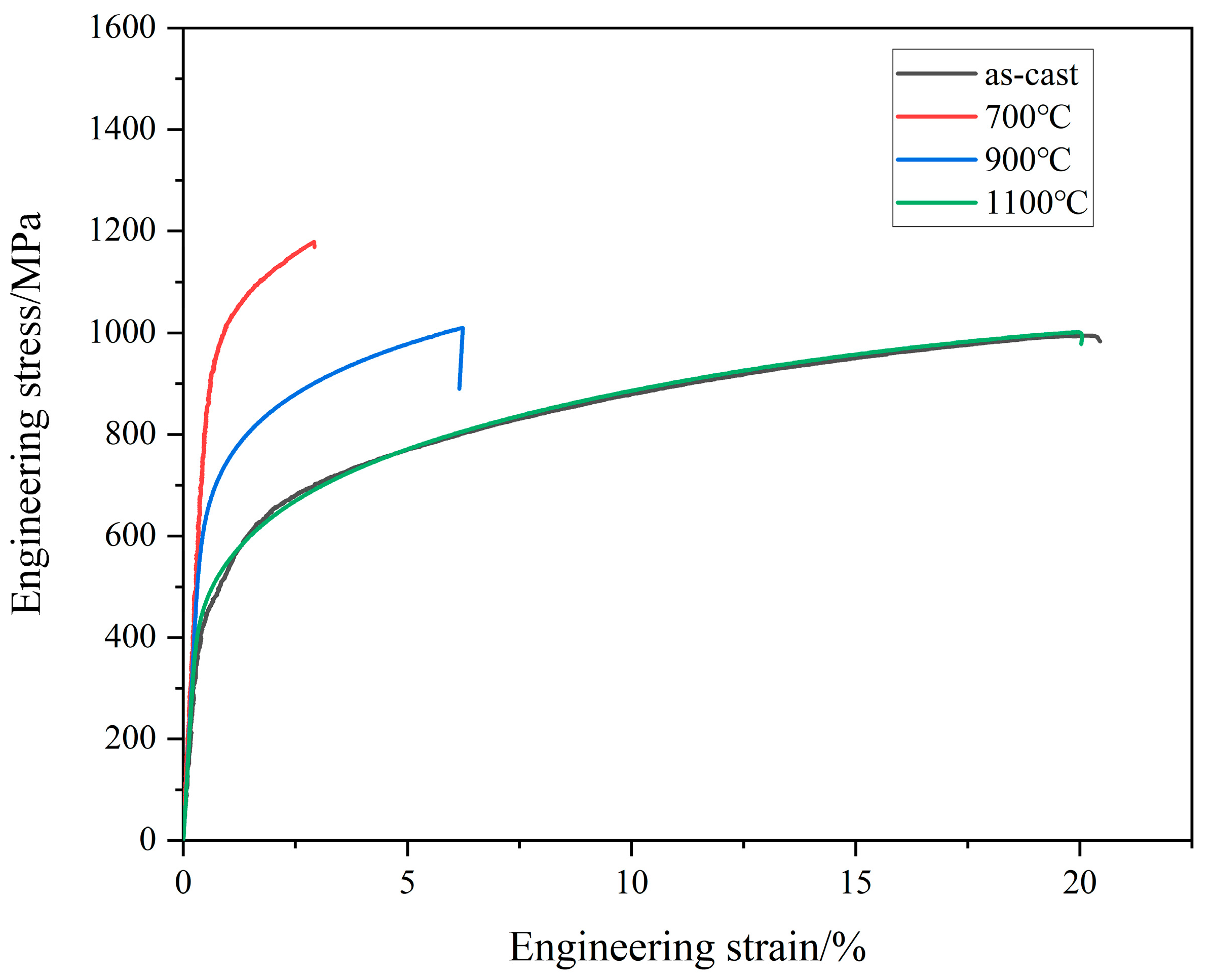
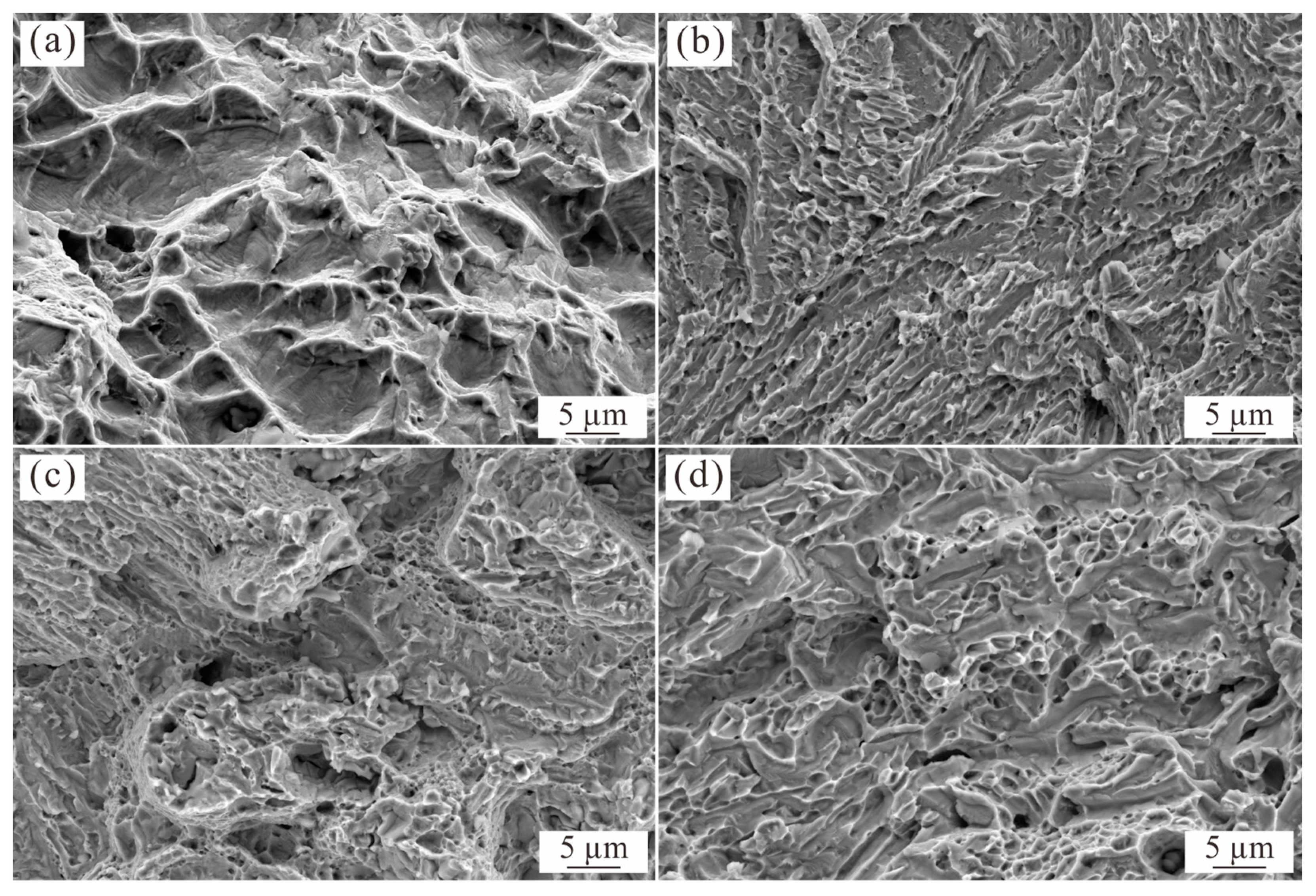
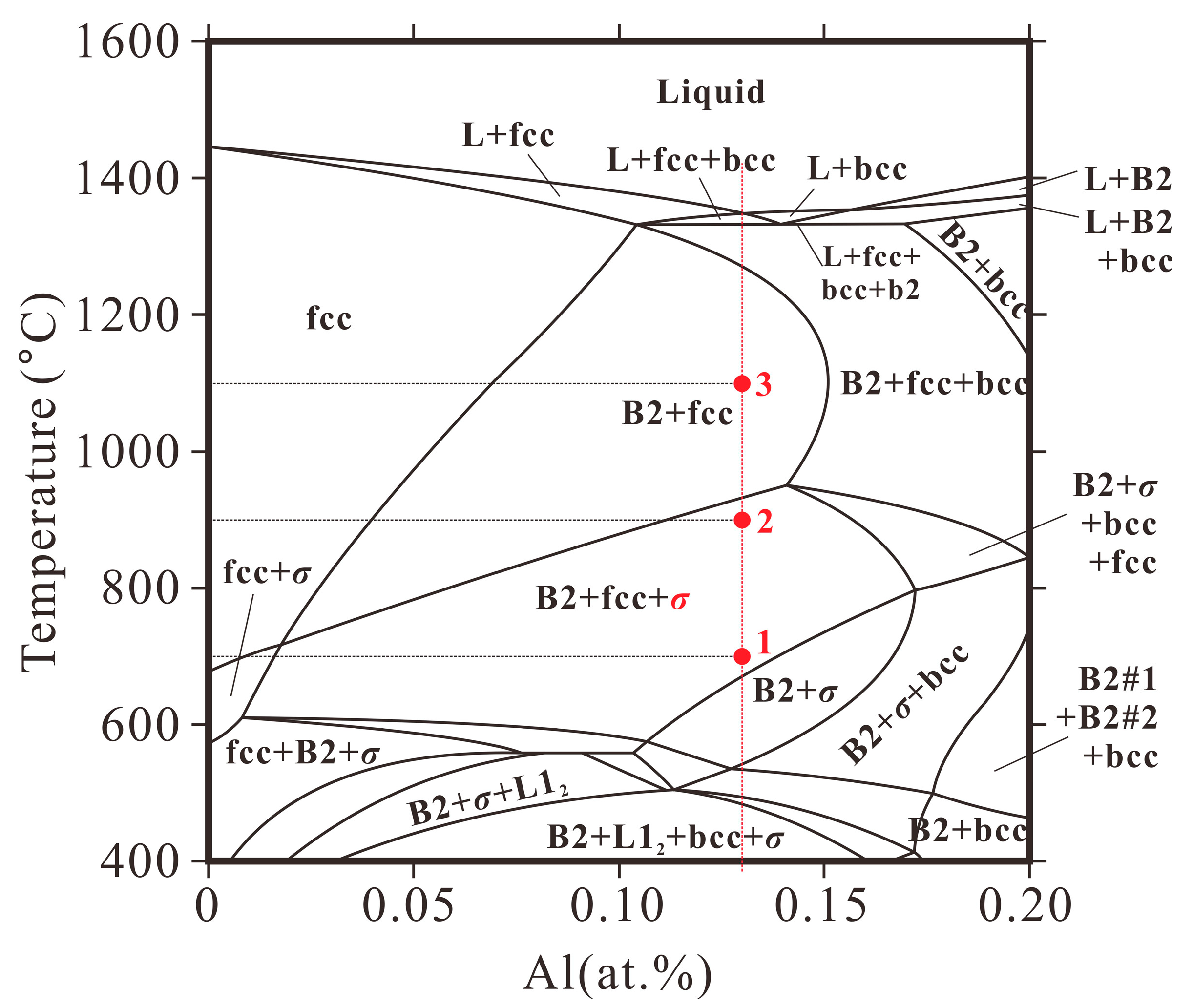
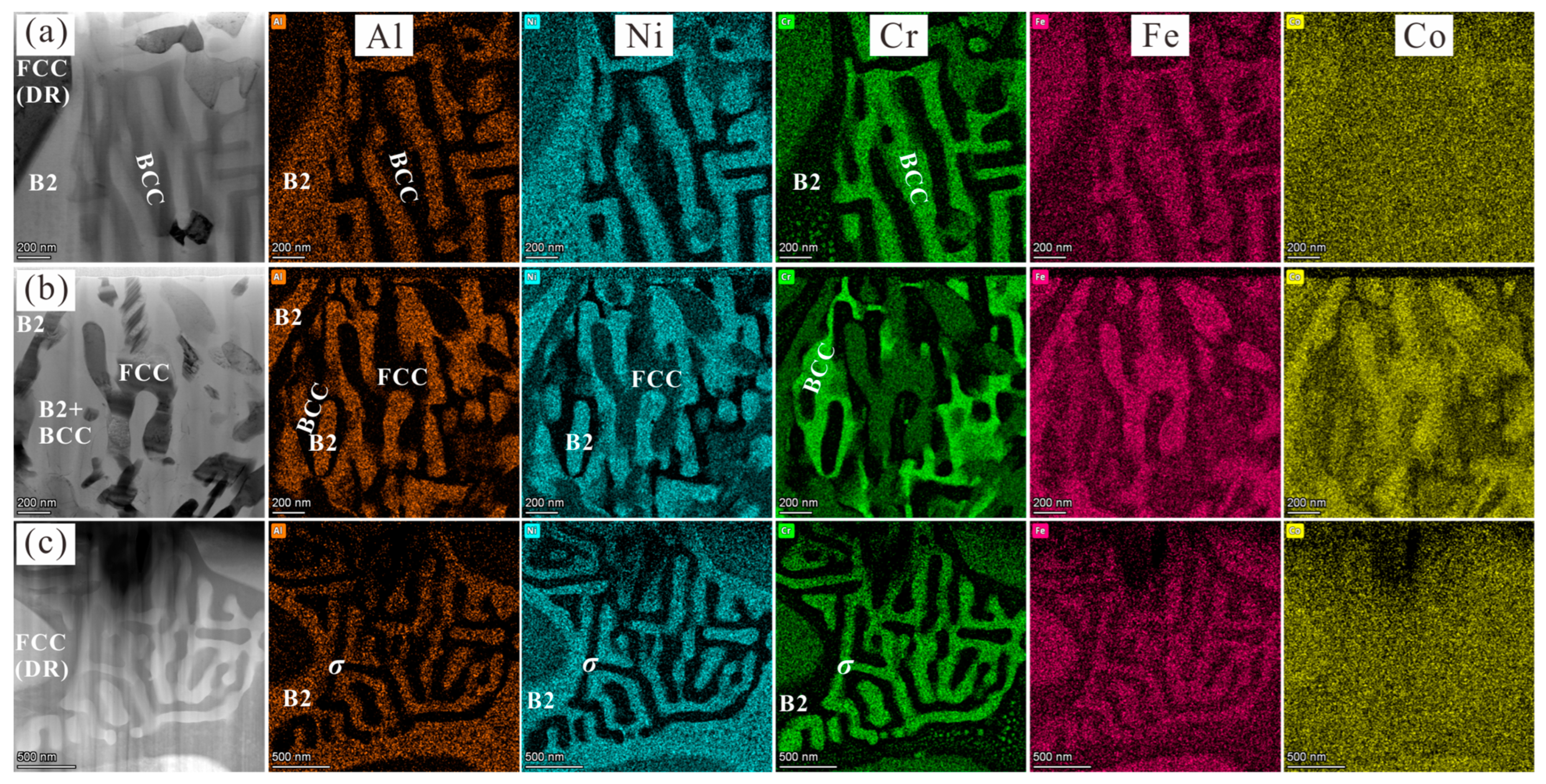
| Al/at.% | Co/at.% | Cr/at.% | Fe/at.% | Ni/at.% | ||
|---|---|---|---|---|---|---|
| Nominal Composition | 13.0 | 21.7 | 21.7 | 21.7 | 21.7 | |
| Area-1 | Average | 13.1 ± 0.1 | 22.3 ± 0.1 | 21.6 ± 0.4 | 21.8 ± 0.2 | 21.1 ± 0.4 |
| Area-2 | Average | 12.9 ± 0.3 | 22.5 ± 0.1 | 21.7 ± 0.3 | 21.7 ± 0.2 | 21.2 ± 0.2 |
| Area-3 | Average | 12.9 ± 0.3 | 22.4 ± 0.2 | 21.7 ± 0.3 | 21.8 ± 0.2 | 21.1 ± 0.2 |
| Al/at.% | Co/at.% | Cr/at.% | Fe/at.% | Ni/at.% | ||
|---|---|---|---|---|---|---|
| Area-1 | FCC phase (DR) | 10.6 ± 0.2 | 19.0 ± 0.1 | 24.9 ± 0.5 | 24.7 ± 0.7 | 20.7 ± 0.9 |
| ID region | 15.5 ± 0.5 | 20.8 ± 0.2 | 23.4 ± 0.2 | 20.8 ± 0.3 | 19.6 ± 0.2 | |
| Area-2 | FCC phase (DR) | 11.1 ± 0.1 | 23.0 ± 0.2 | 21.4 ± 0.3 | 22.3 ± 0.2 | 22.3 ± 0.3 |
| ID region | 15.5 ± 0.3 | 20.9 ± 0.2 | 23.5 ± 0.4 | 20.9 ± 0.5 | 19.2 ± 0.5 | |
| Area-3 | FCC phase (DR) | 10.8 ± 0.3 | 23.0 ± 0.6 | 21.5 ± 0.3 | 23.2 ± 0.4 | 21.3 ± 0.3 |
| ID region | 15.7 ± 0.3 | 20.7 ± 0.3 | 23.0 ± 0.5 | 20.8 ± 0.3 | 19.8 ± 0.3 | |
| Al/at.% | Co/at.% | Cr/at.% | Fe/at.% | Ni/at.% | |
|---|---|---|---|---|---|
| FCC phase (DR) | 7.9 ± 0.3 | 24.3 ± 0.4 | 26.6 ± 0.2 | 24.6 ± 0.4 | 17.1 ± 0.4 |
| B2 phase (ID) | 31.7 ± 0.5 | 16.9 ± 0.5 | 9.5 ± 0.2 | 12.0 ± 0.4 | 30.1 ± 0.4 |
Disclaimer/Publisher’s Note: The statements, opinions and data contained in all publications are solely those of the individual author(s) and contributor(s) and not of MDPI and/or the editor(s). MDPI and/or the editor(s) disclaim responsibility for any injury to people or property resulting from any ideas, methods, instructions or products referred to in the content. |
© 2023 by the authors. Licensee MDPI, Basel, Switzerland. This article is an open access article distributed under the terms and conditions of the Creative Commons Attribution (CC BY) license (https://creativecommons.org/licenses/by/4.0/).
Share and Cite
Hou, P.; Yang, Y.; Zhang, L.; Meng, Y.; Cui, Y.; Cao, L. Effect of Heat Treatment on the Microstructure and Mechanical Properties of the Al0.6CoCrFeNi High-Entropy Alloy. Materials 2023, 16, 7161. https://doi.org/10.3390/ma16227161
Hou P, Yang Y, Zhang L, Meng Y, Cui Y, Cao L. Effect of Heat Treatment on the Microstructure and Mechanical Properties of the Al0.6CoCrFeNi High-Entropy Alloy. Materials. 2023; 16(22):7161. https://doi.org/10.3390/ma16227161
Chicago/Turabian StyleHou, Pengyu, Yue Yang, Leilei Zhang, Yi Meng, Yan Cui, and Leigang Cao. 2023. "Effect of Heat Treatment on the Microstructure and Mechanical Properties of the Al0.6CoCrFeNi High-Entropy Alloy" Materials 16, no. 22: 7161. https://doi.org/10.3390/ma16227161
APA StyleHou, P., Yang, Y., Zhang, L., Meng, Y., Cui, Y., & Cao, L. (2023). Effect of Heat Treatment on the Microstructure and Mechanical Properties of the Al0.6CoCrFeNi High-Entropy Alloy. Materials, 16(22), 7161. https://doi.org/10.3390/ma16227161






